Mosaic Blanket
What a joy it is to discover those moments in knitting when something seemingly intricate turns out to be very easy!
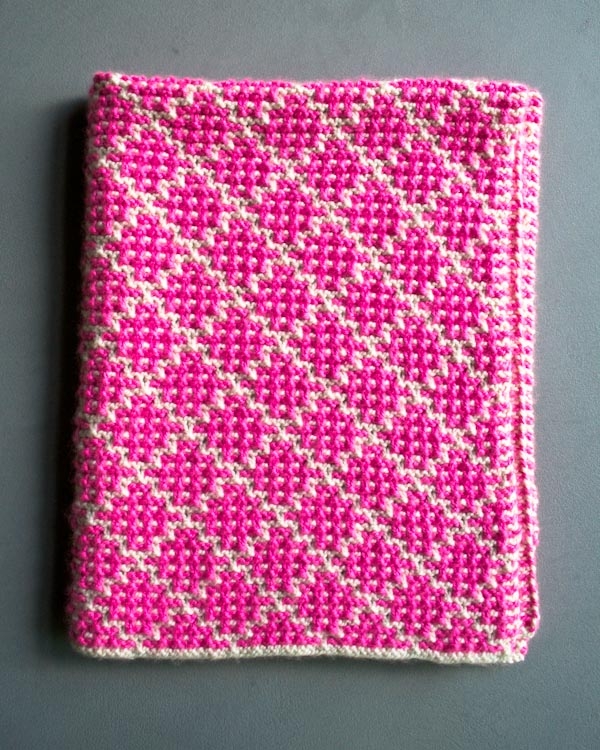
Those are the moments that knitting legend Barbara Walker strove to find as she first learned how to knit. Finding color work’s bobbins and multiple strands of yarn cumbersome, she developed a slip-stitch technique she called “Mosaic Knitting,” a clever way to create elaborate, colorful patterns using only basic stitches (knit, slip and occasionally purl). Soon, she was staying up late into the night inventing hundreds of original mosaic motifs, guided solely by her imagination.
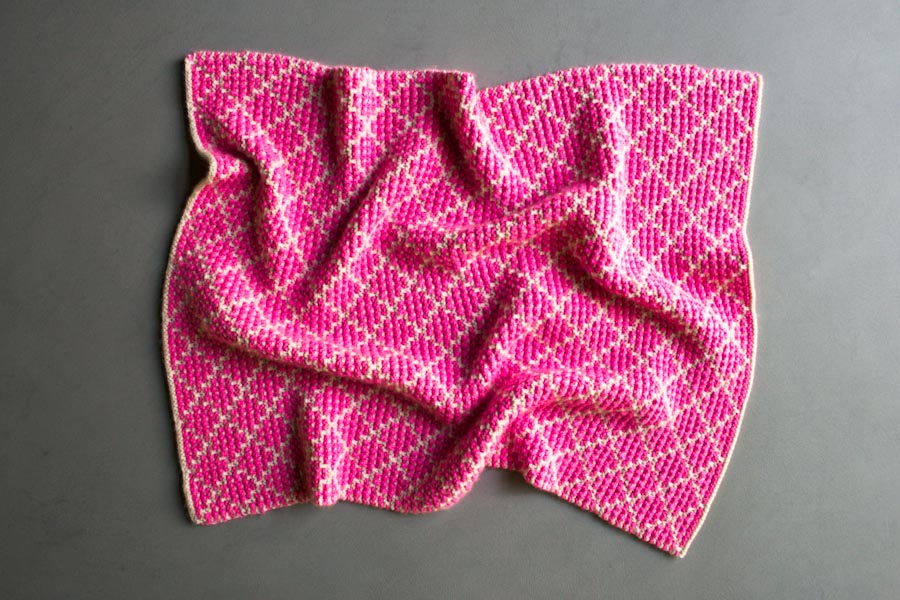
With a motif from Walker’s Second Treasury of Knitting Patterns, we created our Mosaic Blanket, made in Purl Soho’s incredibly soft Alpaca Pure in vibrant, almost glowing Super Pink, and anchored by the sturdy smoothness of Worsted Twist in creamy Heirloom White.
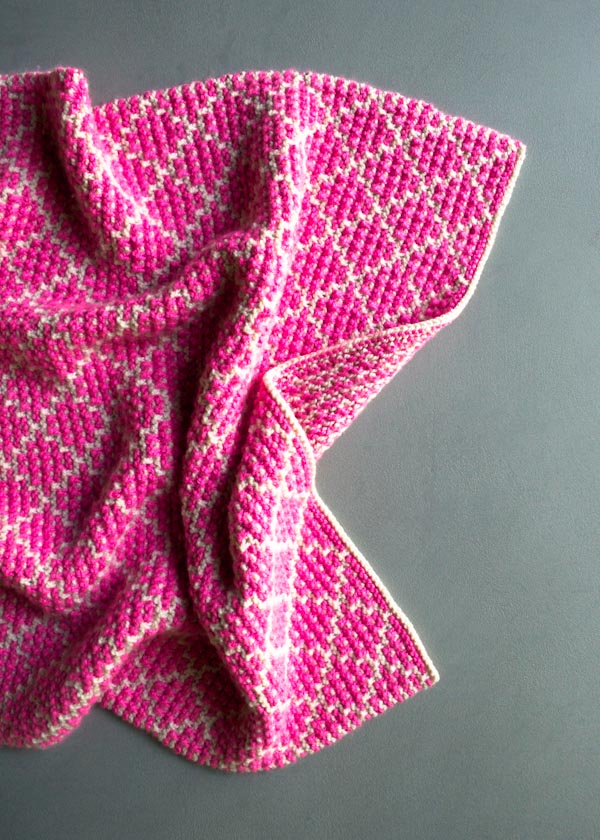
As Barbara Walker herself discovered, there is beauty in simplicity… Although you won’t have to tell anyone just how simple this Mosaic Blanket actually is to make! -Kristy
Update: New Color!
May 17, 2017
Our Mosaic Blanket has become one of our most popular patterns, which may surprise you, given how complicated it looks to make. But the real surprise is that even an advanced beginner can cast on for this knitting adventure! For this version of our Mosaic Blanket we used Worsted Twist in classic Heirloom White and Alpaca Pure in mysterious Trout Brown, an earthy neutral at heart with a shimmer of blue across its surface. For additional images, check out our new post!
Designed by Purl Soho designer, Kristina McGowan. Click here to see even more of Kristina’s designs!
Share your progress and connect with the community by tagging your pics with #PurlSoho, #PurlSohoBusyHands, #PurlSohoMosaicBlanket, and #PurlSohoWorstedTwist. We can’t wait to see what you make!
Materials
- Color A: 4 (6, 7) skeins of Purl Soho’s Worsted Twist, 100% merino wool. Each skein is 164 yards/ 100 grams; approximately 656 (984, 1148) yards required. (NOTE: We no longer offer Worsted Twist, but choose from one of our other worsted/aran weight yarns.)
- Color B: 6 (8, 10) skeins of Purl Soho’s Alpaca Pure, 100% super baby alpaca. Each skein is 109 yards/ 100 grams; approximately 654 (872, 1090) yards required. (NOTE: We no longer offer Alpaca Pure, but choose from one of our other worsted/aran weight yarns.)
- A US 8 (5 mm), 24 or 32-inch circular needles
Here are four palette ideas, including the one knit up here!
• Color A: Heirloom White
• Color B: Super Pink
• Color A: Heirloom White
• Color B: Artemisia
• Color A: Heirloom White
• Color B: Yellow Zest
• Color A: Heirloom White
• Color B: Dark Loam
Gauge
19 stitches x 38 rows = 4 inches in Mosaic Stitch, using Colors A and B
15 stitches x 32 rows = 4 inches in garter stitch, using Color A
Sizes
Baby (Crib, Throw)
- Finished Measurements: Approximately 26 x 35 (33 ½ x 40, 41 x 46 ½) inches
SAMPLE: We knit the Baby size.
Notes
SLIP STITCHES
ON RIGHT SIDE ROWS: Slip stitches with yarn in back.
ON WRONG SIDE ROWS: Slip stitches with yarn in front.
STITCH MULTIPLE
This pattern works over a multiple of 12 stitches + 3. For example, 12 x 4 = 48; 48 + 3 = 51 total cast-on stitches.
MOSAIC KNITTING
To see how easy it is check out this Mosaic Blanket video tutorial, below!
Pattern
With Color A, cast on 123 (159, 195) stitches. We used a basic Long Tail Cast On.
NOTE: To help keep track of the stitch pattern, you may want to place a stitch marker (or piece of scrap yarn) between each 12-stitch repeat on the next row.
Set-Up Row (wrong side): With Color A, knit.
Work Mosaic Pattern either from Written Instructions or Chart, both below.
MOSAIC PATTERN: WRITTEN INSTRUCTIONS
Row 1 (right side): With Color B, k1, *slip 1 (see Notes), k11, repeat from * to last 2 stitches, slip 1, k1.
Row 2 and all following wrong side rows: Knit the same stitches you knit on the previous row, with the same color; and slip all of the same slipped stitches, with the yarn in front (see Notes).
Row 3: With Color A, k4, *[slip 1, k1] 3 times, slip 1, k5, repeat from * to last 11 stitches, [slip 1, k1] 3 times, slip 1, k4.
Row 5: With Color B, k3, *slip 1, k7, slip 1, k3, repeat from * to end of row.
Row 7: With Color A, k2, *slip 1, k3, slip 1, k1, repeat from * to last stitch, k1.
Row 9: With Color B, k5, *slip 1, k3, slip 1, k7, repeat from * to last 10 stitches, slip 1, k3, slip 1, k5.
Row 11: With Color A, k2, *slip 1, k1, slip 1, k5, [slip 1, k1] 2 times, repeat from * to last stitch, k1.
Row 13: With Color B, k7, *slip 1, k11, repeat from * to last 8 stitches, slip 1, k7.
Rows 15 and 16: With Color A, repeat Rows 11 and 12.
Rows 17 and 18: With Color B, repeat Rows 9 and 10.
Rows 19 and 20: With Color A, repeat Rows 7 and 8.
Rows 21 and 22: With Color B, repeat Rows 5 and 6.
Rows 23 and 24: With Color A, repeat Rows 3 and 4.
Repeat Rows 1–24 thirteen (17, 20) more times.
Repeat Rows 1–14 one more time.
Continue to Finishing section, below.
MOSAIC PATTERN: CHART
Instead of following the written text above, you may find it easier to follow this chart instead. A few notes on how to follow mosaic charts …
Starting in the bottom right corner of the Chart below, each horizontal row represents two rows of knitting. Work right-side (odd number) rows from right to left and wrong-side (even number) rows from left to right.
For rows that begin and end with a Color B (gray) square, all Color B stitches are knitted and all Color A stitches are slipped. For rows that begin and end with a Color A (white) square, all Color A stitches are knitted and all Color B stitches are slipped.
Work Rows 1–24 of the Chart 14 (18, 21) times; then, repeat Rows 1–14 one more time.
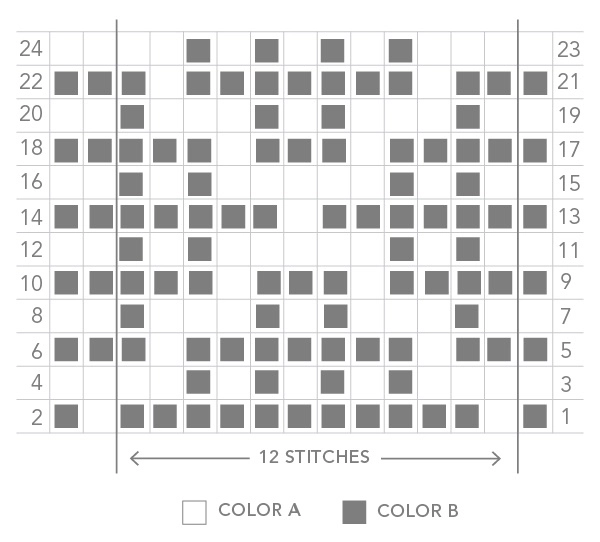
FINISHING
Cut Color B.
Next Row (right side): With Color A, knit 1 row.
Next Row (wrong side): With Color A, bind off all stitches knitwise.
Weave in the ends, gently wet block and enjoy!


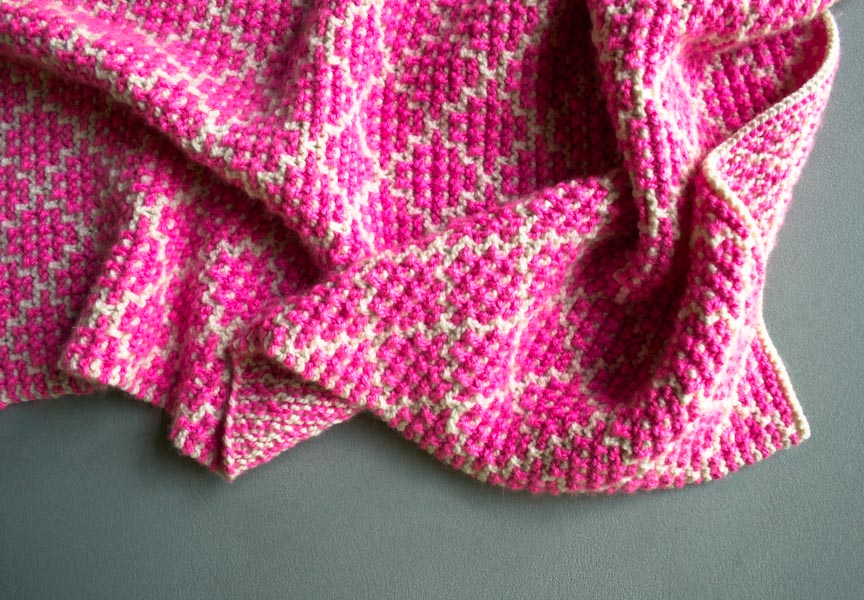

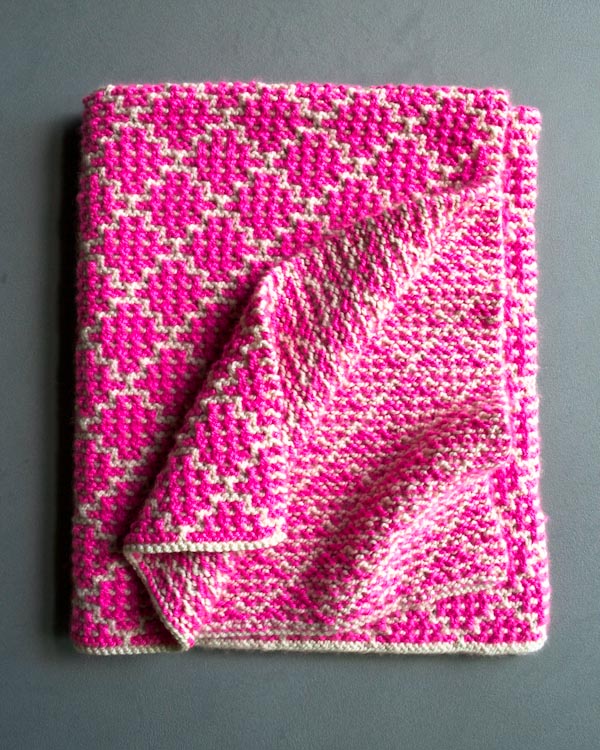
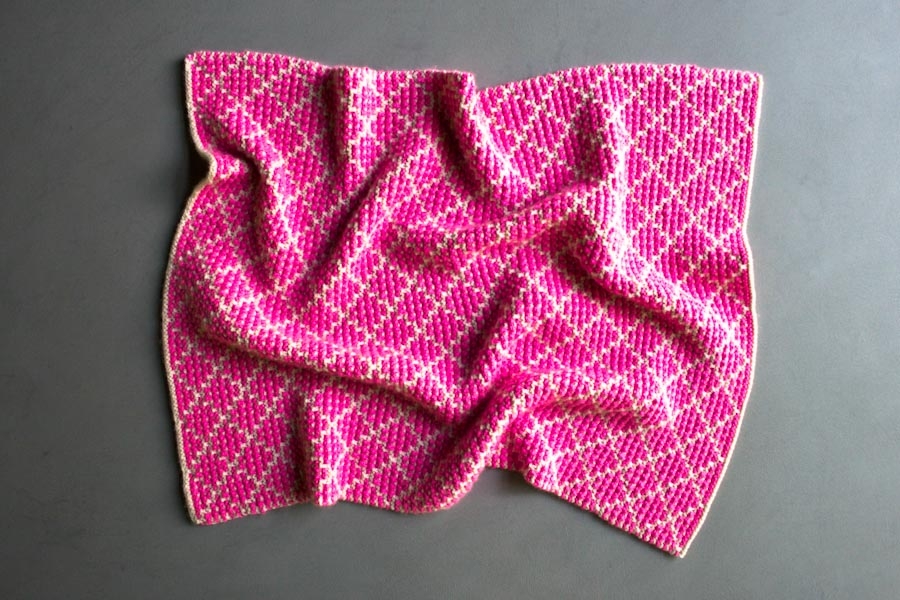
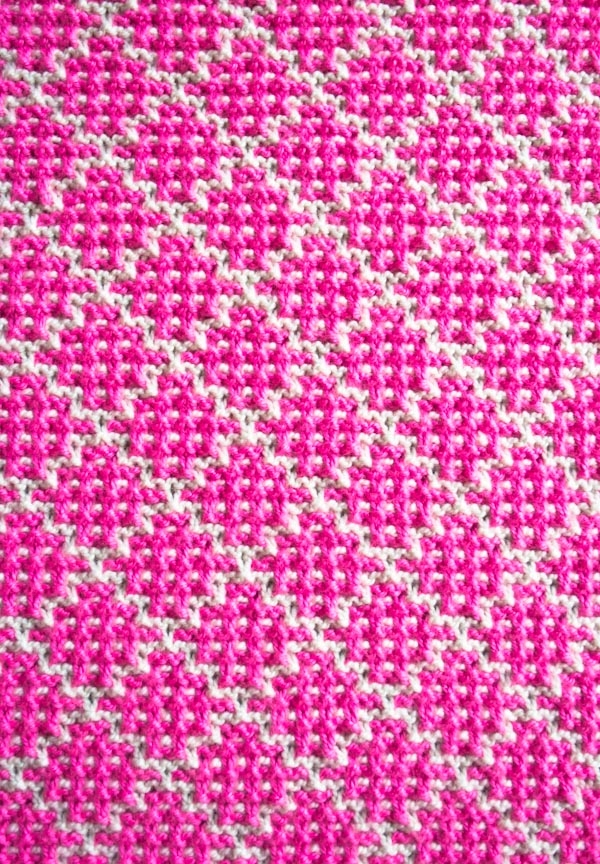
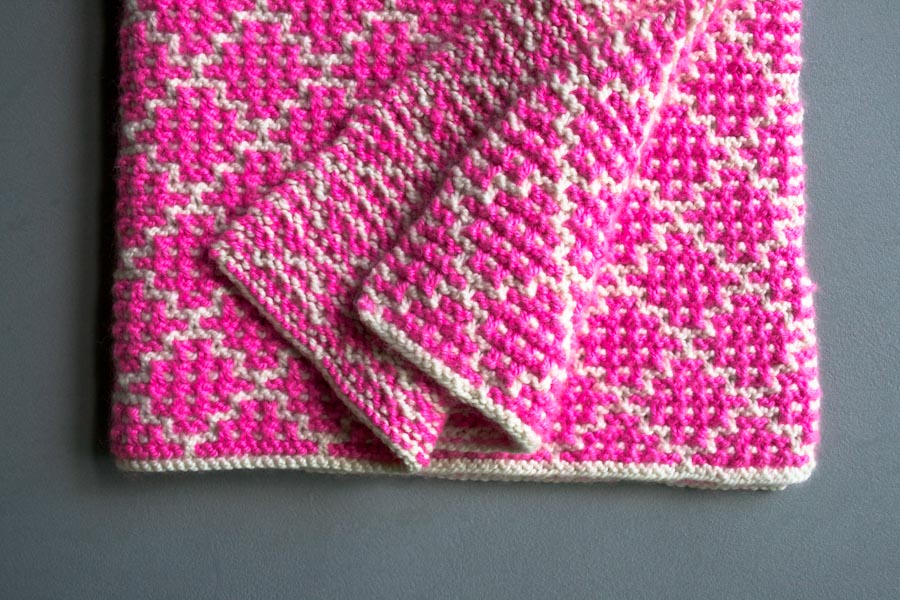
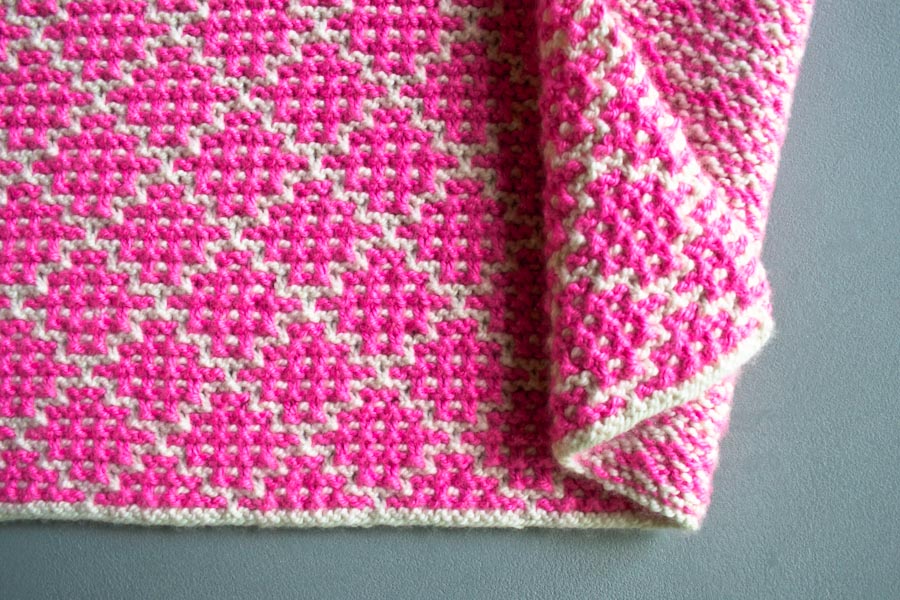

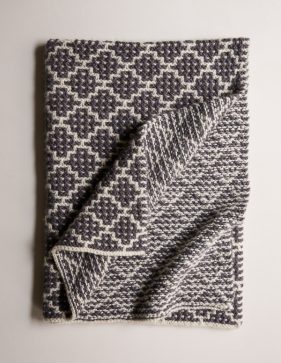
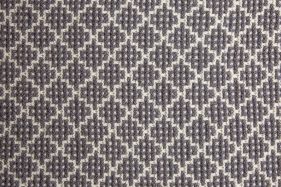
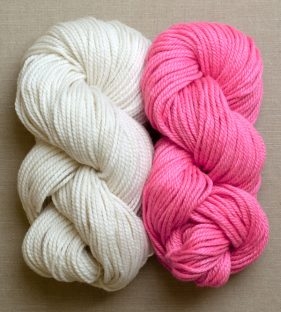
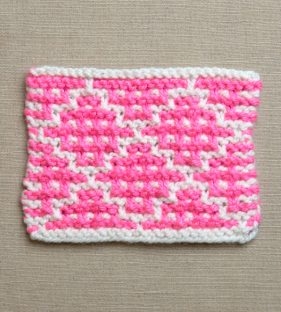
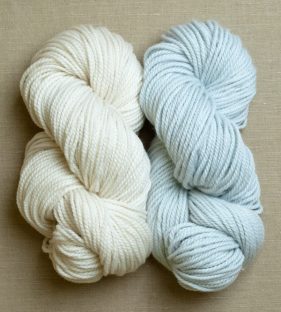
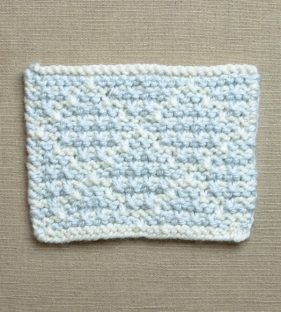
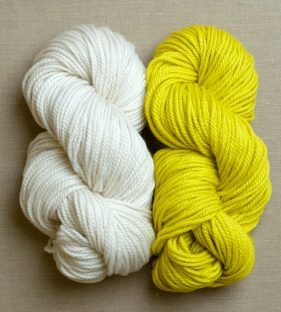
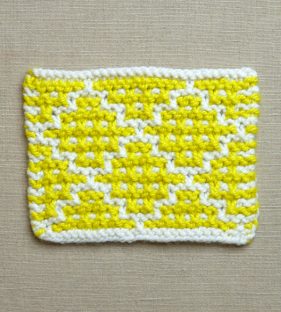

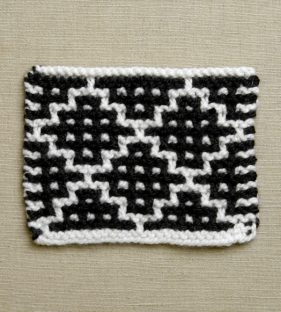


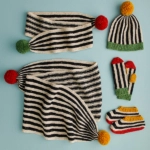

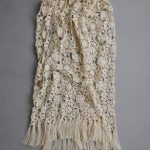
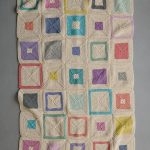

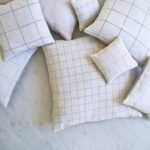
Hello! I love this pattern. I am thinking about making it as a baby gift but in Valley Yarns Superwash. Do you think that yarn would work as a good substitute? Thanks very much!
Hi Maggie,
Thanks for reaching out! Any worsted weight yarn should work for this pattern! I would recommend doing a gauge swatch with whichever yarn you choose before beginning to make sure that your gauge is consistent with the pattern!
Happy knitting!
Gianna
I am pretty excited about this blanket. I want make it a little bit larger which doesn’t seem to be a problem at all. My question is, do you think it would be OK to use acrylic worsted weight. I’m thinking about Lion Brand Pound of Love.
Hi Shelly,
Thanks for reaching out! Yes, it would be very easy to adjust the pattern to be bigger size! You can use any worsted weight yarn but be sure to do a gauge swatch prior to starting the pattern to insure that your gauge is in line with the pattern!
Happy knitting!
Gianna
I see where the number of skeins are listed, but what about total ounces of yarn required.
Thanks.
Hi Melanie,
Thanks for reaching out! we don’t have the yardage listed here since it uses a yarn that has been discontinued (Alpaca Pure) but we have an updated version so you can find that here! For this blanket we used approximately 656 (984, 1148) yards Color A and 654 (872, 1090) yards Color B!
I hope this helps!
Warmly,
Gianna
Could this mosaic pattern be used for a hat?
Thanks for reaching out! This mosaic pattern would be so fun used in a hat! We don’t currently have a hat pattern designed with this mosaic, but it’s definitely a great idea. I’ll let our development team know, and maybe we’ll be able to introduce a version sometime in the future!
All the best,
Kelsey
What stitch count, higher than 195, would I need to make the blanket wider? Is there a certain number to add by? And if so, how many inches would it approximately add? Thank you for helping with is question.
Hi Steph,
Thanks for reaching out! If you want to change the sizing, just cast on a multiple of 12 plus 3 stitches. For example, 12 x 4 = 48. 48 + 3 = 51 cast-on stitches. I would recommend starting out by working a swatch, then if your gauge is consistent with the pattern and depending on the width you would like you can calculate your cast on from there!
I hope this helps, happy knitting!
Gianna
Love the Mosaic blanket pattern, however I do not knit. I crochet. That being said, can the chart work for crochet? Thanks!!
Hi Jacquela,
Thanks for writing in! That is an excellent question! I haven’t heard of anyone working from the chart for crochet before but I think it could certainly be possible!
If you try this out please let us know how it turns out, happy crafting!
Gianna
I’m contemplating knitting the Mosaic Blanket for my granddaughter’s first year in college.
I’d like to make a larger size (60x?) in an oblong shape. Can you tell me the # of stitches to cast on and size needle? Math is not my area of expertise and I’ve enjoyed reading your recommendations to other folks. Thanks.
Hi Kathleen,
Thanks for reaching out! What a special gift!! Luckily this pattern is very easy to adjust, if you want to change the sizing, you just need to cast on a multiple of 12 plus 3 stitches. For example, 12 x 4 = 48. 48 + 3 = 51 cast-on stitches. So if you want approximately a 60″ wide blanket, and if your gauge is consistent with the pattern (4.75 stitches per inch) You would take 4.75 x 60 = 285 (this gives you an exact number of stitches for 60″ but then you need to use the formula to determine the correct number for the stitch pattern to work properly) So from there, you can either use 12 x 23 = 276 + 3 = 279 stitches or 12 x 23 = 288 + 3 = 291 stitches. Casting on 279 stitches will give you a bit smaller than 60″ and 291 stitches will give you a bit more than 60″, whichever you decide will work great, and from there you can knit until you reach your desired length!
I hope this helps and please let me know if you have any more questions!
Gianna
Hi. I am about to start knitting this beautiful blanket and have two questions: (1) How important is it to do a gauge in Mosaic Stitch? Can I skip it and just do in Garter Stitch? (2) When you make the size of the blanket larger, I see that the length increases by 7.5 inches. But the width increases from 35 to 40 inches (therefore by 5 inches) and then from 40 to 46.5 inches (therefore by 6.5 inches). How can I figure out/calculate the changes in the width when the blanket is larger than this? Thank you.
Hi Kikko,
Thanks for reaching out! The gauge is important to ensure that the blanket comes out the correct size and not too small or too large. You can use garter stitch for this blanket, but then you would just be making a garter stitch blanket, so at that point, it would be much easier to use a different blanket pattern! The dimensions of this blanket are based on the standard sizes of a baby, crib, and throw size blanket, there isn’t a specific formula to increase the size. So if you plan on making a larger blanket you can select a size totally based on your preference. You just need to select the size of the width you would like, from there, if your gauge is consistent with the pattern you can calculate your cast on amount. Just be sure to keep in mind that the stitch pattern for the Mosaic stitch works over a multiple for 12 + 4 stitches. For example, if you would like a 50″ blanket you would cast on 243 stitches (12 x 20 = 240 + 3 = 243) Then you will simply follow the pattern until you reach your desired length.
I hope this clears things up, happy knitting!
Gianna
Hello,
I have a question on Row 3 the written out patters say , you K4, (slip 1 k1) three times, slip 1, K5. Is k5 correct? I was thinking it would be 4 . I just started the blanket and wanted to ask before I continue.
Thank you.
I figured it out! I think I was awake counting it out in my head last night. No need to answer. thank you.
Hi Dawn,
I’d be happy to clarify this section of the pattern for you! I’ve worked up a swatch of my own to double-check it, and I can confirm that the pattern directions are correct as written. If you take a look at the chart for the stitch pattern (reading right to left), you’ll notice in Row 3 that in the 12-stitch repeat section there are 3 stitches in Color A at the beginning of the brackets and 2 stitches in Color A at the end. These five stitches represent the k5 listed in the written instructions, so you can see how they fit into the overall pattern!
I hope this helps clear things up, but you can always reach out to us at customerservice@purlsoho.com for additional help!
Warmly,
Kelsey
I can’t find the link to the Mosaic Blanket Techniques video. Can you help?
Hi Tammy,
Thanks for reaching out! Unfortunately, we don’t offer a video tutorial for this pattern, but we have a great selection of tutorials for techniques available. You can find our full list of tutorials here: Knitting Tutorials
Warmly,
Gianna
Hi Tammy,
Here’s a link for the purl soho mosaic tutorial:
https://youtu.be/tBMdq8WOSWc
If the link doesn’t work type ‘Mosaic Blanket: Techniques | Purl Soho’ into YouTube.
I found the video so useful, as it helped me to have the confidence to start my first pattern. It’s was posted a while ago, so it’s not on the purl soho website, but only on their YouTube as far as I can tell.
Happy knitting,
Sam
Hi! I’m having trouble with row 11! I’m ending up with the wrong amount at the end and other issues. The written instructions has k2 at the beginning and then start the stitches between the asterisks, which would have a k1 before starting the next set of 12 stitches… But in the chart there is another k1 space, I assume before you start the next set of 12. So are the written instructions correct? Or the chart? Should I be adding another k1 before doing the next set of 12? I was sailing right along before that row! I’ve studied it and tried to find similar patterns, tried to do the math, etc but I can’t figure it out. Thanks in advance!
Hi Mary,
Thanks for reaching out. I took a look at the pattern, and I can’t find any errors in that row! I can certainly see how Row 11 (and many of the other odd-numbered rows, like Row 7, as well) is confusing in this regard. Perhaps if it were written out to match the chart, that would help! Here’s how that would look:
Row 11: k1 *[k1, slip 1] twice, k5, slip 1, k1, slip 1, repeat from * to last 2 stitches, k2
Hope this helps!
All the best,
Lili
Good day
Please help. I am knitting this blanket and I wanted to find out if it is possible to do this in ombre for the colour B. If so when would I switch the colour B to a lighter shade ? I was going to do so from row 1 in the pattern repeat but then part of the “diamonds” would still be in the old colour.
Hi Genesa,
Thanks for reaching out. I think that an ombre effect would be a lovely addition to this design! Because the diamond motifs are positioned on their points, rather than on their flat edges, I’m afraid that part of them will always be the old color no matter where you switch colors. But I think that this will look really nice and actually add to the ombre effect since it will obscure the color shift!
All the best,
Lili
Hi there — when beginning a new odd numbered row, should I pull the new color in front of or behind the old color? Which makes the neatest edge? Thank you for the lovely pattern!
Hi Katie,
Thank you so much for the kind words!
When working the slipped edge stitches, you will be slipping with the yarn held in back on the right side, and slipping with the yarn held in front on the wrong side!
I hope this helps! Please feel free to reach out again with any questions!
All the best,
Carly
What in the world am I doing wrong?
The pattern is in 15 stitch increments, except for rows 3, 9, and 13. For those 3 rows, the pattern is in 27 stitch increments. I’ve doubled, and triple, checked my math.
So if you cast on 123 stitches, you would do 8.2 repeats, except for rows 3, 9, and 13. For those rows you would do 4.55 repeats. WTF?!?
I must REALLY be missing something, the pattern makes no sense as written above! Please help!!!!
It appears to be a lovely pattern, except the one above just doesn’t work!!
Hi Janice,
Thanks for reaching out. The repeated section of this pattern is actually a 12-stitch repeat on every row, plus 3 stitches for the edge! The pattern is comprised of either 10, 13, or 16 groups of 12 stitches, plus those additional 3 stitches. Here’s how the math works out for each size of the blanket:
12 stitches x 10 repeats + 3 additional stitches = 123
12 stitches x 13 repeats + 3 additional stitches = 159
12 stitches x 16 repeats + 3 additional stitches = 195
To visualize this, I’d recommend following the charted version of the pattern, rather than the written version, if you aren’t already doing so. I find it easier to work from a chart with a pattern like this, personally. I hope this helps clear things up, and please let me know if you have any other questions!
All the best,
Lili
I just finished row 7, colour A. Knitted row 8 (wrong side) in same colour. The next row (row 9) says knit colour B.
But my colour B is up the other end of my work.. have I made a big mistake? Or do I just cut the wool and start with Colour B again up this end? Is colour B meant to keep carrying up the side or cut and reintroduced? Hope that makes sense! Thank you!
Hi Leah,
Thanks for reaching out! In mosaic knitting, every group of 2 rows is knit with the same color. So for this pattern, that means that Rows 1+2 are in Color B, Rows 3+4 are in Color A, Rows 5+6 are in Color B, etc. After every group of 2 rows (so, after you’ve completed knitting an even/wrong side row), both colors should always be at the same edge of your work.
Since you’re finding that that’s not the case at this point, then there is definitely something odd going on! What may have happened is that you skipped Row 6 entirely, leaving Color B at the opposite end of your work. I’d recommend undoing a few rows until you’re back to a point where both colors are on the right edge of your work, with the right side facing you.
Hope this helps get you back on track!
All the best,
Lili
Good Afternoon,
Do you have any suggestions for yarn since most of the worsted twist colors are no longer available. I have made this once with the worsted twist. Thanks so much.
Hi Dawn,
I think that Plenty would be a wonderful choice for this blanket! It’s a worsted weight, 100% merino yarn just like Worsted Twist, so it will make a lovely blanket.
As always though, we recommend knitting a gauge swatch before casting on your project, especially when you are substituting yarns. You may need to size up or down your needles in order to get the correct gauge!
All the best,
Lili
Yesterday I started and finished a potholder with this pattern.
Easy enough for a beginner like myself but also fun an interesting thanks to the slip stitches.
I wil make another one and interchange both colours which will turn my potholders into a cute pair.
Thank you for this gorgeous pattern!
I am on the 2nd repeat of the pattern and am pretty sure there are errors in rows 5-11. Instead of nice diamonds, there are small squares being made at the widest part of the diamonds on each side. I am following the instructions carefully. I am on a deadline and do not have time to rip this out and start over.
Hi Cindy,
Thanks for reaching out, although I’m sorry to hear that your blanket isn’t turning out as expected! Would you be able to send photos of your work so far to customerservice@purlsoho.com? That way, we can visualize exactly what’s going on and give you advice on how to move forward in your project!
All the best,
Lili
Hi Could this blanket be knitted in 4 ply for a baby?
Hi Teresa,
Thanks for reaching out. You can absolutely use a different weight yarn for this pattern, you would just need to adjust the number of stitches you cast on so that it comes to the size that you want!
To figure out your cast-on number, you will want to first knit a gauge swatch in pattern (if this is daunting, we have a wonderful tutorial called All About Gauge). Once you know how many stitches you are getting per inch, you can multiply that number by the width that you would like and cast on the nearest multiple of 12 + 3. Then you can follow the pattern as written!
All the best,
Lili
Hi! I’ve read the directions a few times and looked through the comments, but I’m still a little confused about knitting the knits and slipping the slipped stitches on the wrong side row. Are every 2 rows essentially going to be me following the directions for the right side row with the only change being the yarn held in back for RS or front for WS? So I’d be working the directions for one row twice just changing where my yarn is on the slipped stitches? Thanks so much!
Hi Alexis,
You’ve got it! Each wrong side row will be exactly the same as the previous right side row, just with the working yarn held on the opposite side of the work (though this technically ends up being the same side, since you’ve turned the work).
All the best,
Lili
Thank you so much! I’m casting on now, but I’m confused with where to put my first stitch marker! I get that there are 12 stitches in each repeat, but it looks like it shifts. Thank you!
You can place the first stitch marker after one stitch, and then one stitch marker after each group of 12 stitches, leaving 2 stitches at the other edge after the final stitch marker! The 12-stitch repeat remains constant (in that it’s the same stitches being repeated within each group pf 12 stitches), even though the diamond pattern appears shifted.
All the best,
Lili
Hi, I want to start this blanket and I’m wondering about using two colors of the same weighted yarn. In the instructions color b is thicker. Do I need to be concerned about that switch?
Thank you!
Hi Alma,
Thank you for writing in! I would definitely recommend making a gauge swatch to see how you like the fabric when using the same weight of yarn for both A & B! This will also help you check if you are able to meet the same gauge of the pattern. I hope this helps!
Happy knitting,
Gavriella